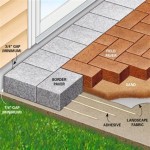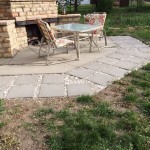How To Install Patio Pavers Over Concrete
Installing patio pavers over an existing concrete slab presents a viable solution for enhancing the aesthetic appeal and functionality of outdoor spaces. This method offers several advantages, including eliminating the need to demolish and remove the existing concrete, saving time and reducing labor costs. The process, however, requires careful planning and execution to ensure a durable and visually appealing finished product. This article provides a detailed guide on how to successfully install patio pavers over concrete.
Before commencing the installation, it is crucial to assess the condition of the existing concrete slab. Cracks, uneven surfaces, and drainage issues must be addressed to prevent future problems with the paver installation. Ignoring these issues can lead to paver shifting, water accumulation, and eventual damage to the entire patio surface.
Assessment and Preparation of the Concrete Slab
The initial step involves a thorough inspection of the concrete slab. All cracks should be identified and evaluated for severity. Small hairline cracks may be acceptable, but wider cracks or those indicating structural instability necessitate repair. Concrete patching compounds are suitable for filling smaller cracks, while larger, more complex cracks may require professional assistance to ensure long-term stability.
Uneven surfaces also require attention. A self-leveling concrete compound can be used to create a smooth and consistent base for the pavers. This is particularly important if the concrete slab has significant dips or slopes that could cause the pavers to become unstable or misaligned. The self-leveling compound should be applied according to the manufacturer's instructions, ensuring proper coverage and curing time.
Drainage is another critical consideration. If the concrete slab does not have adequate drainage, water can accumulate beneath the pavers, leading to mold growth, paver shifting, and eventual degradation of the underlying concrete. To address this, consider installing a drainage system before laying the pavers. Options include incorporating a slight slope to direct water away from the house or installing a subsurface drainage system to collect and redirect water.
Cleaning the concrete slab is essential to ensure proper adhesion of the paver base. This involves removing all dirt, debris, oil stains, and loose particles. A pressure washer can be used to effectively clean the surface, removing stubborn stains and grime. After pressure washing, allow the concrete to dry completely before proceeding to the next step.
Once the concrete is clean and dry, apply a concrete bonding agent. This product enhances the bond between the concrete slab and the paver base, preventing slippage and ensuring a more durable installation. The bonding agent should be applied according to the manufacturer's instructions and allowed to dry completely before proceeding.
Selecting Materials and Tools
Choosing the right materials is crucial for a successful paver installation. Consider the type of pavers, the paver base material, the joint sand, and any necessary edging materials.
Pavers come in various materials, including concrete, brick, and natural stone. Concrete pavers are a popular choice due to their durability, affordability, and wide range of styles and colors. Brick pavers offer a classic, timeless look, while natural stone pavers provide a unique and elegant aesthetic. The choice of paver material depends on personal preference, budget, and the overall design of the patio.
The paver base material is placed between the concrete slab and the pavers to provide a stable and level surface. A common choice is a layer of leveling sand or a specialized paver base panel system. Leveling sand is relatively inexpensive and easy to work with, but it may require more maintenance over time. Paver base panel systems offer superior stability and drainage, but they are typically more expensive. Regardless of the material chosen, ensure it is compatible with the chosen paver type and the existing concrete slab.
Joint sand is used to fill the spaces between the pavers, providing stability and preventing weed growth. Polymeric sand is a popular choice due to its ability to harden and prevent erosion. It is important to select a joint sand that is compatible with the chosen paver type and the paver base material.
Edging materials are used to contain the pavers and prevent them from shifting or spreading. Options include plastic edging, metal edging, and concrete curbing. The choice of edging material depends on the desired aesthetic and the level of stability required. Plastic edging is a cost-effective option, while metal edging provides a more modern look. Concrete curbing offers the highest level of stability and durability.
In addition to the materials, certain tools are essential for a successful paver installation. These include a measuring tape, a level, a shovel, a wheelbarrow, a tamper, a rubber mallet, a circular saw with a masonry blade, and a broom. A plate compactor may also be necessary for compacting the paver base material.
The Installation Process
With the concrete slab prepared and the materials and tools gathered, the installation process can begin. The following steps outline the process for installing patio pavers over concrete:
First, establish the layout of the pavers. This involves determining the desired pattern and ensuring that the pavers fit within the designated area. It is helpful to dry-lay the pavers before applying the paver base material to visualize the final layout and make any necessary adjustments.
Next, install the edging material. The edging should be installed along the perimeter of the patio area, ensuring that it is level and securely fastened to the concrete slab. This will prevent the pavers from shifting and maintain the integrity of the patio.
Apply the paver base material. If using leveling sand, spread a thin layer of sand over the concrete slab, ensuring it is evenly distributed. Compact the sand with a tamper or plate compactor to create a stable and level surface. If using a paver base panel system, install the panels according to the manufacturer's instructions, ensuring they are properly aligned and secured.
Lay the pavers according to the chosen pattern. Start at one edge of the patio and work your way across, placing each paver firmly into the paver base material. Use a rubber mallet to gently tap the pavers into place, ensuring they are level with each other. Maintain consistent spacing between the pavers to allow for joint sand.
Cut the pavers as needed to fit around obstacles or edges. A circular saw with a masonry blade can be used to cut the pavers to the desired size and shape. Wear safety glasses and a dust mask when cutting pavers to protect your eyes and lungs.
Once all the pavers are laid, sweep joint sand into the spaces between the pavers. Use a broom to distribute the sand evenly and ensure that all the joints are filled. Compact the sand with a tamper or plate compactor to provide stability and prevent erosion.
Finally, water the patio to help settle the joint sand. This will also activate any polymeric additives in the sand, causing it to harden and prevent weed growth. Allow the patio to dry completely before putting furniture or other items on it.
Regular maintenance is essential to keep the patio looking its best. This includes sweeping the patio regularly to remove dirt and debris, washing the patio with soap and water to remove stains, and reapplying joint sand as needed to fill any gaps. Addressing any issues promptly will prevent them from escalating into larger problems.

How To Cover A Concrete Patio With Pavers Diy Family Handyman

How To Install Patio Pavers Over An Existing Concrete Slab

How To Install Patio Pavers Over An Existing Concrete Slab

Installing Pavers On Concrete Unilock

How To Install Patio Pavers Over An Existing Concrete Slab

How To Install Patio Pavers Over An Existing Concrete Slab Youtube

Laying Thin Pavers Over Concrete Youtube

How To Cover A Concrete Patio With Pavers Diy Family Handyman

Installing Pavers Over A Concrete Patio

Installing Brick Pavers Over Existing Cement Sidewalk








